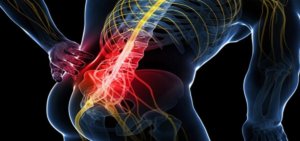By Consultant Neurologist Dr. V. Natarajan…
Pain along the course of the sciatic nerve is referred to as “Sciatica”. The sciatic nerve is a large nerve running along the back of the thigh from the buttocks to the knee where it divides into two nerves which run into the leg.
Irritation of nerve roots L4 L5 S1 also produce pain along the course of the sciatic nerve which it forms, and hence causes Sciatica. In fact, it is irritation of the roots causing sciatica which is more common, than the involvement of the sciatic nerve itself.
What causes Sciatica :
- Lumbar disc prolapse
- Other causes of compression of nerve roots due to age-related changes in the vertebrae, ligaments and infections and tumours.
- Injury to sciatic nerve caused by fractures of bones, surgery, injections.
- Involvement of the sciatic nerve by tumours infection, diabetes and abnormal postures.
However, rupture of one of the lower lumbar intervertebral discs is perhaps the commonest cause of sciatica.
The right foods for every diabetic. Click here to know more
Disc Prolapse:
The disc is the intervening material between two vertebral, which consists of an inner jelly-like material surrounded by fibrous tissue. When there is increased pressure on the discs or vertebrae, the outer fibrous tissue gives way and the gel from inside protrudes into the spinal canal through this dent. This protrudes of the disc material is called disc prolapse.
When the disc protrudes into the spinal canal, it compresses on the nerve root at that level and at times on many roots causing symptoms.

How does one recognize a disc prolapse?
A lower lumbar disc prolapse usually produces sciatica which most often will be associated with a low back pain as well. This pain can be sudden in onset and also recurrent. On examination, there may be a limitation of back and leg movement because of pain, and numbness in leg and or weakness in leg usually on one side.
Usually, this happens on straining as in lifting or pushing a heavy object, and at times on picking objects from the floor or on getting up when a person feels a ‘catch’ in the back.
Management
Rest in bed is the cornerstone in the management of sciatica and or back pain. Absolute rest in lying position with bending of legs at the knees gives considerable relief from pain. Medicines to reduce pain and inflammation along with bed rest is all that is required in the majority of cases. However if there is associated neurologic involvement in the form of numbness or weakness on examination by a doctor, and if this persists along with pain, in spite of bed rest and anti-inflammatory medication then surgery will have to be considered.
At this stage, an MRI of the lumbar region is done to note the degree and extent of compression on the nerve roots.
Surgery:
Surgery would be necessary is only about 10-15% of patients with lower lumbar disc prolapse. As mentioned earlier surgery is reserved for those with neurologic deficits and or those with severe unremitting pain with conservative treatment. The offending disc material is removed by surgery so that the pressure on the nerve root is released.
In a proportion of patients who have been managed with bed rest and medication the pain may recover with the resumption of activity but is usually mild and settles down. Occasionally they may have a recurrence of severe pain when they will have to rest again. Surgery is considered when there is a recurrence of severe pain on more than three occasions.
Treatment for those minority of patients with sciatica due to other causes depends on the cause. Therewith injuries and tumours are treated by surgical procedures while those due to spine degeneration, abnormal postures and diabetes with medication and physiotherapy.
